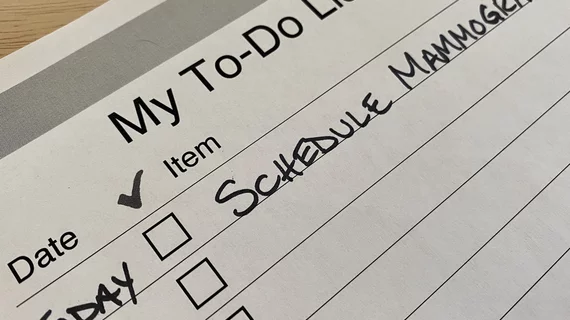Steadily declining mammography screening rates have hit a historic low, new data show
Mammography screening rates have declined steadily since 2010 with some segments of the population impacted more acutely, according to research published Friday.
The proportion of eligible Vermont women who underwent breast cancer screening in the previous two years fell from 61% in 2019 to 56% in 2021 post-pandemic. Screening adherence recovered to 61% by 2022 but remained “substantially lower” than peak levels seen from 2007 to 2010 (66%-67%), researchers detailed in Radiology: Imaging Cancer [1].
“Despite a rebound in 2022 from pandemic-associated lows, mammography screening rates in Vermont are at a historic low, and efforts to increase screening utilization are particularly needed among specific sociodemographic groups,” Brian L. Sprague, PhD, a professor of surgery with the University of Vermont, and c0-authors wrote April 5.
Researchers utilized statewide screening mammography data representing 222,384 women 40 years or older from the Vermont Breast Cancer Surveillance System. The retrospective study spanned 2000 to 2022 and incorporated sociodemographic data and other risk factors influencing mammography adherence.
Sprague et al. estimated an annual percentage decline of 1.1% between 2010 and 2022. Across 95,644 women imaged from January 2018 to March 2020, the probability of returning for screening varied by age (risk ratio = 0.94 for ages 40-44 vs. 60-64), race and ethnicity (risk ratio = 0.84 for black vs. white women), education (risk ratio = 0.84 for less than a high school degree vs. college graduate), and by five-year breast cancer risk (risk ratio = 1.06 for very high vs. average risk).
“Our study, which extends to more than 2.5 years of follow-up since the onset of the pandemic, provides further evidence for racial and ethnic disparities in return to screening and additionally highlights differences according to educational attainment and breast cancer risk,” the authors noted. “Overall, our findings add to a growing literature suggesting that post-pandemic determinants of screening adherence are similar to those observed before the pandemic,” they added.
The start of the decline in screening after 2009 coincided with the release of U.S. Preventive Services Task Force mammography recommendations, which bumped the initial screening age up from 40 to 50. USPSTF later released new recommendations in May 2023, endorsing biennial screening starting at 40. In 2022, only 42% of Vermont women in their 40s underwent screening mammography in the previous two years “indicating that a substantial expansion of mammography screening utilization will be required to achieve high adherence to this new recommendation.”
“The recently released USPSTF draft recommendation for routine screening beginning at the age of 40 years may offer an opportune moment to reinvigorate efforts to promote mammography screening adherence in the post-pandemic era,” Sprague et al. wrote.

